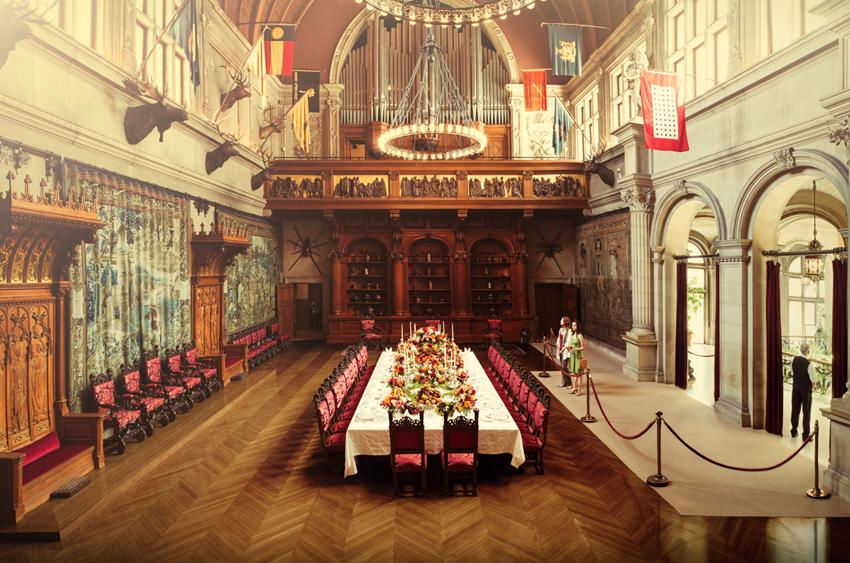
Photo courtesy of Biltmore
How Biltmore Came About
George Washington Vanderbilt (1862-1914), who would build Biltmore House and establish the Biltmore Estate, was the youngest child of Maria Kissam and William Henry Vanderbilt (1821-1885). William Henry Vanderbilt was believed to be the wealthiest man in the world at the time, with a wealth in today’s buying power of about $50 billion, having inherited most of his moolah from his father, Cornelius “Commodore” Vanderbilt (1784-1877). The Vanderbilt fortune came initially from shipping and railroads. The Commodore, like some other 19th century multi-millionaires (multi-billionaires in today’s dollars), later in life became a philanthropist. On his money Vanderbilt University was established. Son William Henry continued running railroads and shipping lines and added new investments.
Now, back to George. A fave of his dad William Henry, young George grew up shy and introverted. He was interested in books and ideas, not in business. He was never involved in the running of any of the family railroad and shipping businesses. Eventually he would become fluent in eight foreign languages and amass a library of 23,000 books at Biltmore House.
Following his grandfather’s death in 1877 and his father’s death in 1885, George inherited a total of around $13 million, plus a mansion on New York’s Fifth Avenue and other real estate. Although $13 million doesn’t sound like all that much today, remember that this was a time before income and most other forms of taxes and a skilled worker earned $3 to $4 a day and a laborer only $1 a day. It is the equivalent of around $1.8 billion in today’s dollar in terms of actual purchasing power, and perhaps more, although you can calculate it in different ways.
George, with his mother, first visited Asheville in early spring of 1888. By that time he had built a yacht and owned a house or two, spending time in Bar Harbor, Me., New York City and Saratoga, N.Y. Asheville was then a small town of around 12,000, but it was becoming known as a fashionable mountain resort town, and, because of its climate and elevation as a healthy place good for the treatment of tuberculosis, malaria, asthma and other ailments. In summer its population swelled to as many as 40,000, with visitors staying at one of eight hotels and about 30 guesthouses. George and his mom stayed at then nearly new and tony 125-room Battery Park Hotel, which had all the modcons of the time including electric lights and elevators. The original Battery Park Hotel, on a hill overlooking the city and with views from the porches of the mountains around, later burned. It was razed and replaced, on a leveled site, by a newer edition constructed by E. W. Grove. Now it is apartments for seniors, just north of the Grove Arcade.
It is not entirely clear why George took such a liking to Asheville, but he appeared to enjoy the climate and the mountain views. Later, he would tell Frederick Law Olmsted: “I came to Asheville with my mother. We found the air mild and invigorating and I thought well of the climate. I enjoyed the distant scenery. I took long rambles and found pleasure in doing so.”
Unlike the better-established fashionable resorts of the time, such as Bar Harbor, Newport, R.I., and Saratoga, the Asheville area still had plenty of undeveloped and cheap land. In 1888 George Vanderbilt began acquiring land, through a straw party, Charles McNamee, a New York attorney related to him by marriage. Soon he had accumulated about 2,000 acres, at prices of from $5 to $20 an acre, mostly purchased from local subsistence farmers.
In late 1888, George Vanderbilt asked Frederick Law Olmsted (1822-1903), by then a highly successful landscape artist responsible for New York’s Central Park (constructed from 1857 to 1873) and many other projects, to come to Asheville and assess the potential of the land for a house, gardens and forest. Olmsted had worked for George on the plans for the grounds of a home he owned in Bar Harbor and for other members of the Vanderbilt family. Olmsted’s first reaction was not entirely positive. He saw the land as “worn out” and “sterile” with “miserable woods and eroded hillsides.” However, Olmsted was not completely negative, and he advised Vanderbilt to create a small park for the house, farm the bottomlands nearby and turn the rest of the land into a tract of managed forest and gameland. Vanderbilt considered Olmsted’s advice and took it. He instructed his attorney to continue buying large tracts of land in the mountain areas nearby. By 1895, the estate comprised some 125,000 acres, including large areas around Mt. Pisgah, about 16 miles from Biltmore House as the crows fly.
All content copyright © Lan Sluder except selected photographs used by permission and brief quotations or other fair use text, which are owned by the copyright holder.
We have made every effort to confirm the accuracy of information on this website, and in the Amazing Asheville book and ebooks, but travel information is subject to frequent change, and no warranty is made, express or implied. Please notify us of any errors or omissions, and we will attempt to correct them as soon as possible. All opinions expressed are those of the author, Lan Sluder, unless otherwise noted.

